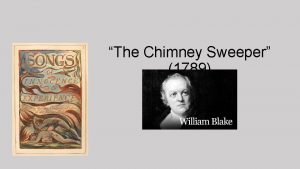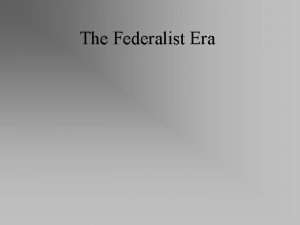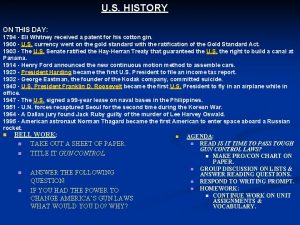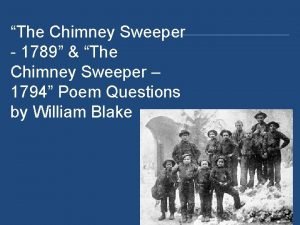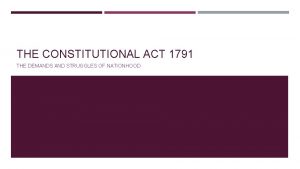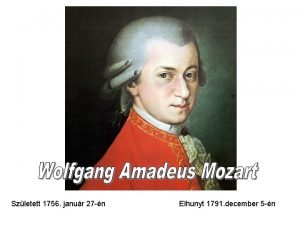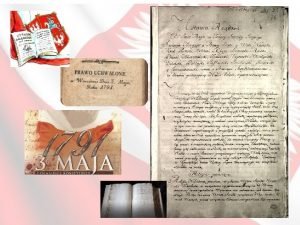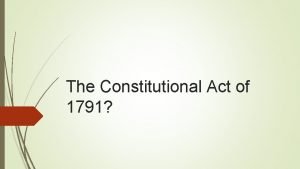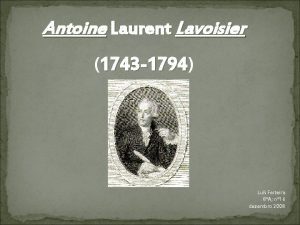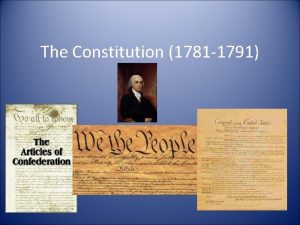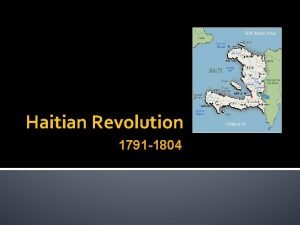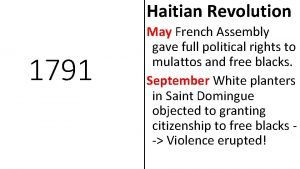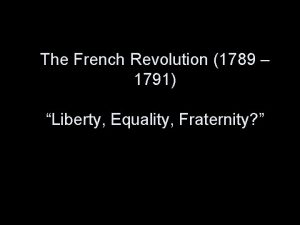The French Revolution 1791 1794 The Path to




















- Slides: 20

The French Revolution: 1791 -1794

The Path to War • Other European monarchs were becoming concerned with the events of the French Revolution. • Aug. 27, 1791: Austrian Emperor Leopold (brother of Marie Antoinette) issues Pillnitz Declaration, threatening consequences if anything happens to the French royal family. • France sees this as a threat, and is also concerned with émigré actions in neighbouring countries. • France declares war on Austria April 20, 1792. • France invades the Austrian Netherlands April 28.

The Brunswick Manifesto • Prussia joins the war, led by the Duke of Brunswick. • He issues the Brunswick Manifesto, declaring that the Allied Army (Austria and Prussia) will restore King Louis to his full powers (i. e. absolute monarchy), and condemns to death any who oppose this (July 20). • In France, this is seen as proof that Louis is collaborating with France’s enemies. • The Allied Army invades France (July 30, 1792).

The Battle of Valmy • • • Fought on Sept. 20, 1792. Major turning point in the war. France battles the Allied Army to a draw. The Prussians decide to withdraw. Great boost to French morale. The next day (Sept 21) the monarchy is formally abolished and the First French Republic is born.

The Battle of Valmy, by Emile-Jean-Horace Vernet

The Paris Commune • The city government of Paris since 1789 • August 10, 1792: revolts against the Legislative Assembly. • Storms the Tuileries (royal residence of Louis in Paris) and takes the royal family prisoner. • This challenges the legitimacy of the Legislative Assembly. • Sept 19, 1792: Legislative Assembly is dissolved.

Paris Commune

The National Convention • French government from Sept 20 1792 to Oct 26, 1795. • Abolishes royalty. • Puts Louis on trial Dec. 3, 1792. • Robespierre: “Louis must die, so that the country may live”. • Citizen Louis Capet guillotined Jan. 21, 1793.

The Vendee Rebellion • Counterrevolutionary rebellion breaks out in the Vendee region in March 1793. • Other centers of counterrevolution: Lyon and Bordeaux. • Led by Monarchists and Catholic Church. • Encouraged by émigrés and Austria. • Civil war between Royalists and Republicans lasts until 1796.

The Committee of Public Safety • Set up by the National Convention in April 1793. • Given dictatorial powers to defeat the counterrevolution. • Becomes the real French government during the Reign of Terror. • Passes the Mass Levy, Law of Suspects and Law of Maximum Price.

Montagnards vs. Girondists • Both Montagnards and Girondists had been members of the Jacobin Club, and both were republicans. • Jacobin Club: political club that met in the monastery of St. Jacques. • Girondists named after the region of Gironde where many Girondists came from. • Montagnards named after “mountain” at the top left of the National Assembly, where they sat. • Montagnards were more extreme, Girondists more moderate.

The Girondists Expelled • The Girondists had more delegates in the National Convention • Girondists had been radicals in the National Assembly, but were conservatives in the National Convention • June 2, 1793: The Montagnards use the National Guard to arrest the Girondists, and throw them out of the National Convention • The Montagnards (radical Jacobins) take control of the Committee of Public Safety

Assassination of Jean-Paul Marat • • • Charlotte Corday: came from a royalist family. Her brothers were emigres. She supported the Girondists. Marat had been a fierce opponent of Girondists. Corday blames Marat for the downfall of the Girondists. • Assassinated him in his bathtub on July 13, 1793.


Maximilien Robespierre • Lawyer and leader of Jacobin Club • Initially opposed war with Austria • One of the most popular orators of the National Convention • He, Georges Danton and Marat were three most popular radical leaders • Elected to the Committee of Public Safety on July 27, 1793


Reign of Terror • Sept 1793 -July 1794 • Mass executions of “enemies of the revolution” • These included Catholics, Monarchists and Girondists • Between 20 000 and 40 000 people executed • “Law of Suspects”: creates “revolutionary tribunals” to try people accused of treason (Sept 17, 1793)

The New Calendar • Created Sept 22, 1793, with Sept 22, 1792 as Year One • Changed names of months • Ten day weeks, three weeks of thirty days per month • Designed to erase old ways

Cult of the Supreme Being • Cult of Reason: atheist, secular religion to replace Christianity • Nov. 10, 1793: Goddess of Reason celebrated at Notre Dame Cathedral, which is renamed Temple of Reason • Robespierre creates Cult of the Supreme Being to replace both Christianity and Cult of Reason • Made national religion on May 7, 1794 by decree of National Convention • June 8, 1794: Festival of Supreme Being

Robespierre’s Downfall • Appears before the National Convention July 26, 1794. • Warns about a conspiracy against the Republic • Hints that members of the Convention are part of the plot, but doesn’t mention any names. • The next day, Robespierre is shouted down when he tries to speak, and is arrested. • On July 28, 1794, Robespierre is guillotined without a trial • The Terror is brought to an end
 You should hope this game will be over soon
You should hope this game will be over soon Russian revolution vs french revolution
Russian revolution vs french revolution 1794-1743
1794-1743 The chimney sweeper songs of experience
The chimney sweeper songs of experience Era section 1
Era section 1 1794-1743
1794-1743 Introduction (blake, 1794)
Introduction (blake, 1794) 1794-1743
1794-1743 The chimney sweeper 1794
The chimney sweeper 1794 Constitutional act 1791
Constitutional act 1791 1756 salzburg
1756 salzburg 1791-1756
1791-1756 Adam stanisław krasiński konstytucja 3 maja
Adam stanisław krasiński konstytucja 3 maja Wolfgang amadeus mozart (1756–1791)
Wolfgang amadeus mozart (1756–1791) Decreto 1791 de 1996
Decreto 1791 de 1996 Constitutional act of 1791
Constitutional act of 1791 Volfgangs amadejs mocarts
Volfgangs amadejs mocarts Monarchie constitutionnelle 1791
Monarchie constitutionnelle 1791 Unity signalr
Unity signalr Definition of third agricultural revolution
Definition of third agricultural revolution Four phases of the french revolution
Four phases of the french revolution



